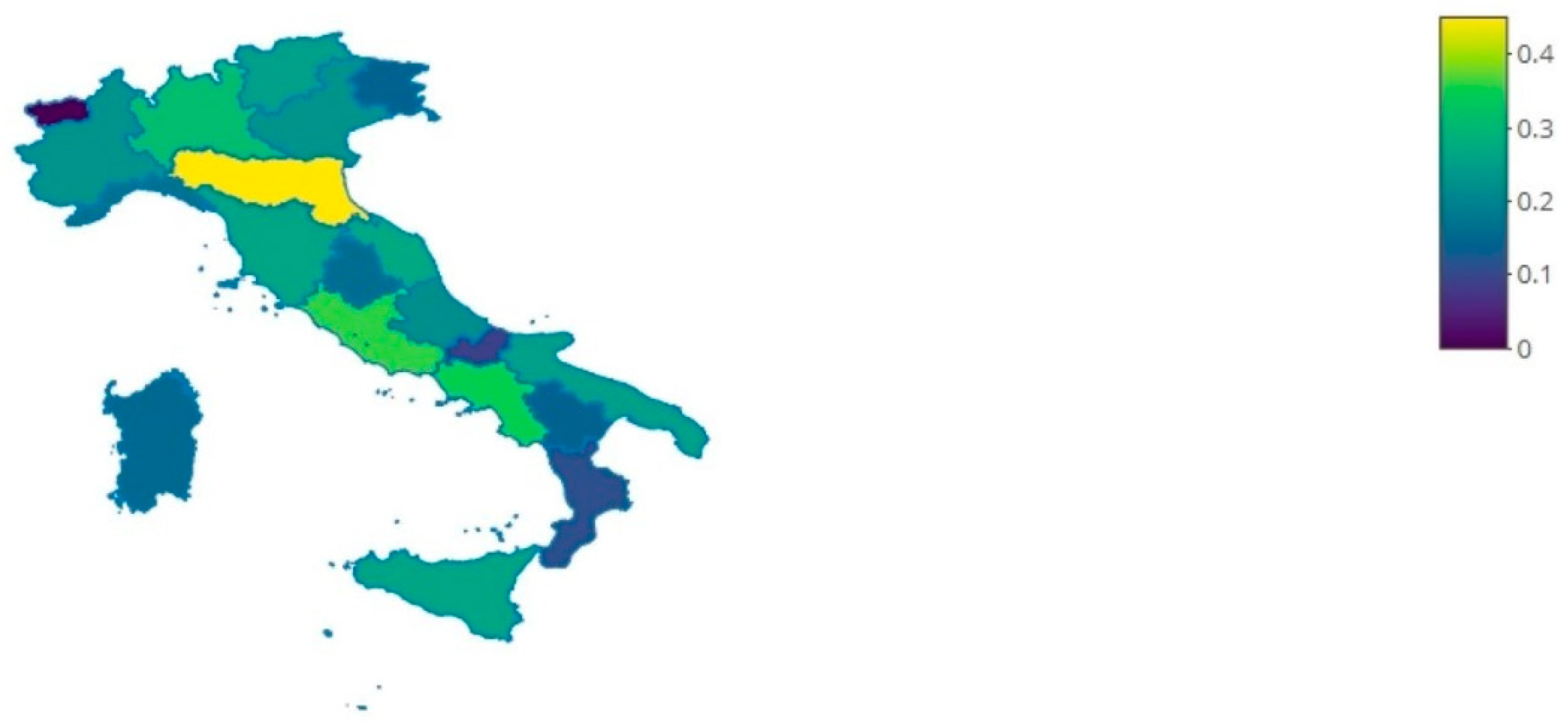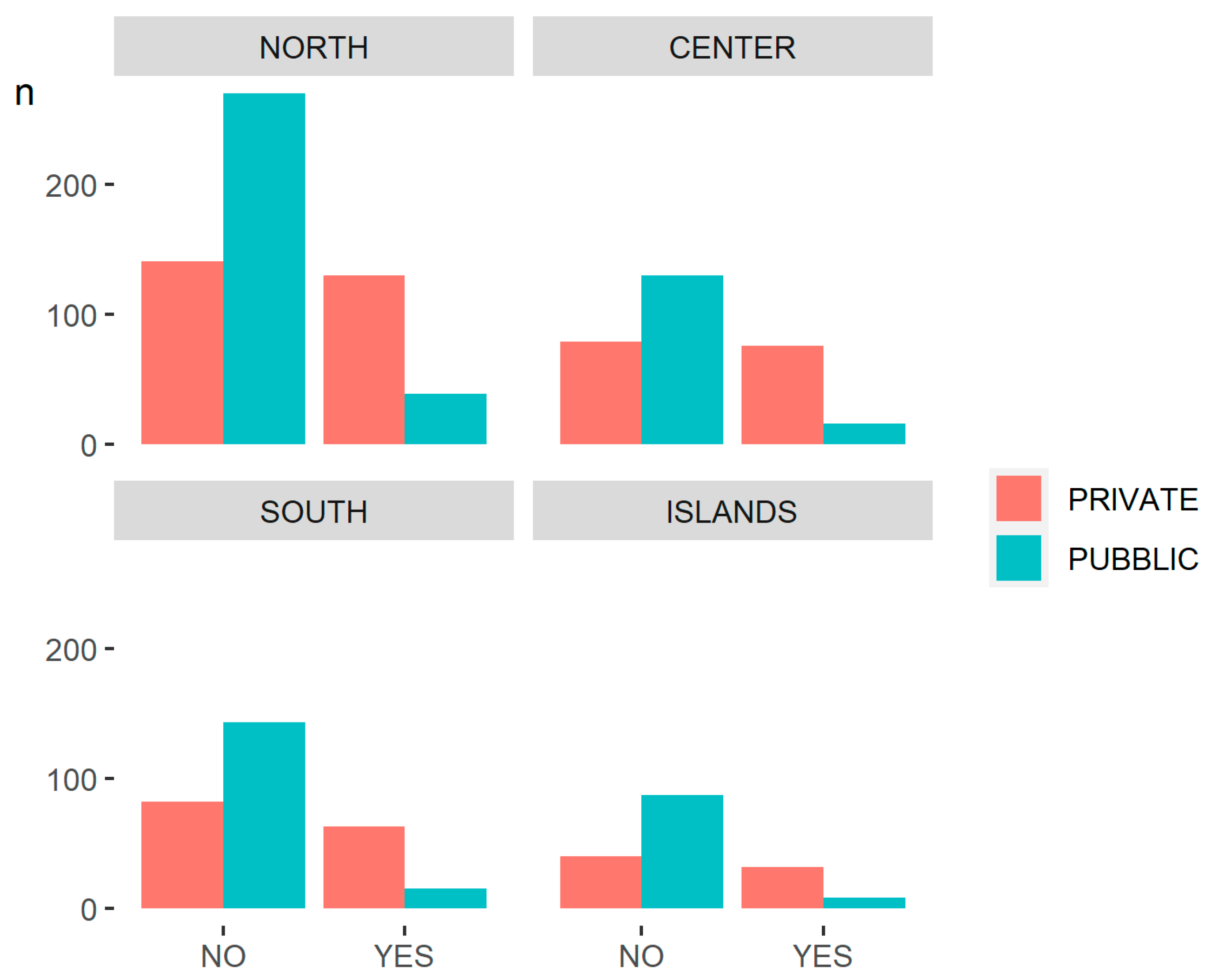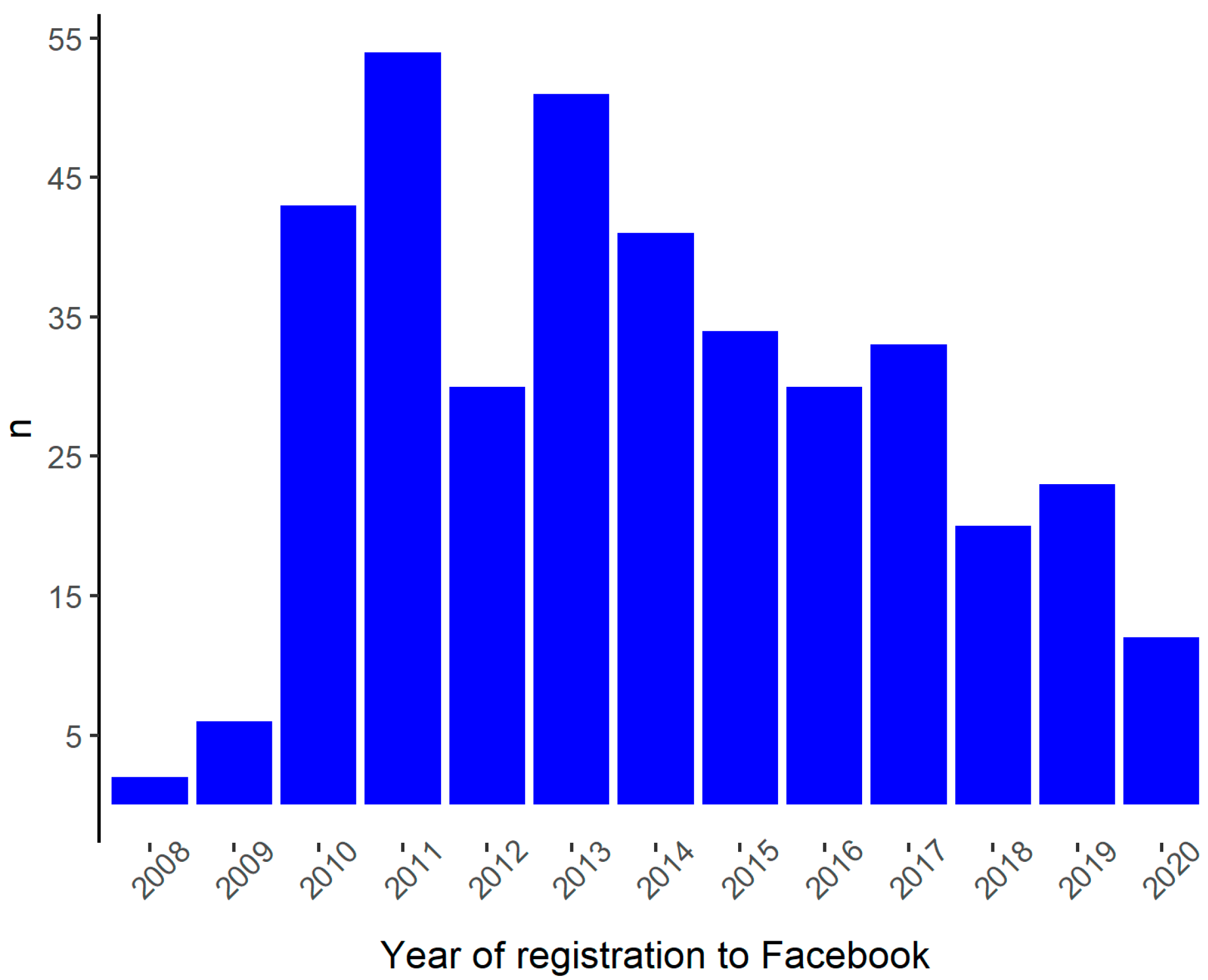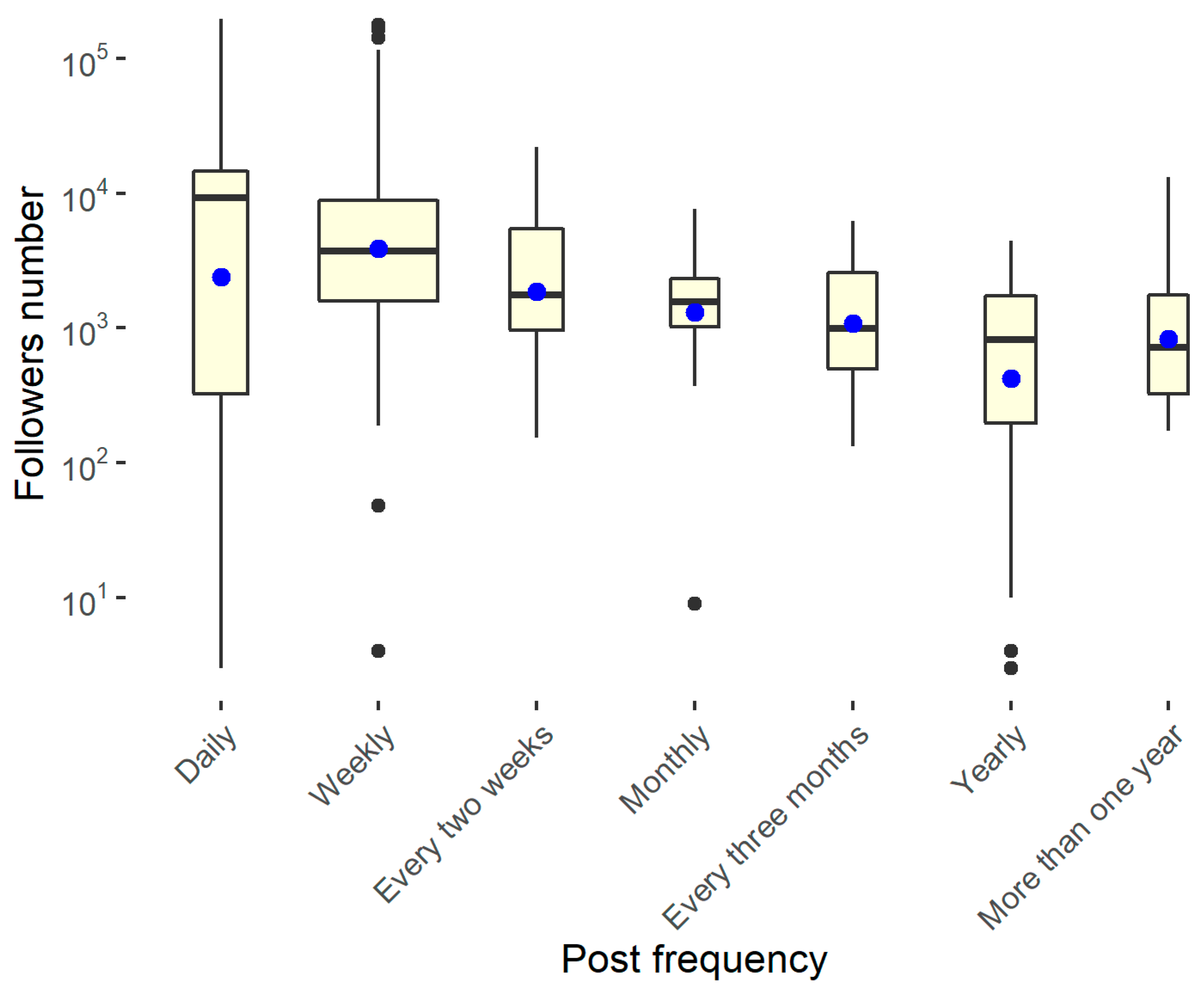Overview of Facebook Use by Hospitals in Italy: A Nationwide Survey during the COVID-19 Emergency
Abstract
:1. Introduction
- Given the impact of social media on patients’ clinical choices, how much attention is paid by hospitals on the information and scientific communication to patients through social networks?
- Is the information provided frequently updated?
- Are there differences in the use of social networks between public and private hospitals in Italy?
- Are there any virtuous examples of healthcare organizations that are able to communicate effectively on social media?
2. Materials and Methods
2.1. Data Collection
2.2. Characteristics and Sampling of the Facebook Pages
2.3. Statistical Analysis
3. Results
3.1. Distribution of Official Facebook Pages across Italian Hospitals
3.2. Distribution of Posts in May and October
3.3. Distribution of Publication Frequency
3.4. “Followers” Distribution
3.5. “Like” Distribution
4. Discussion
4.1. Principal Findings
4.2. Limitations
5. Conclusions
Supplementary Materials
Author Contributions
Funding
Institutional Review Board Statement
Informed Consent Statement
Data Availability Statement
Conflicts of Interest
References
- Kemp, S. Digital 2020: Italy. Available online: https://datareportal.com/reports/digital-2020-italy (accessed on 25 May 2021).
- Facebook Reports Second Quarter 2020. Available online: https://investor.fb.com/investor-news/press-release-details/2020/Facebook-Reports-Second-Quarter-2020-Results/default.aspx (accessed on 25 May 2021).
- The Ottawa Charter for Health Promotion. Am. J. Prev. Med. 1994, 10, 48–50. [CrossRef]
- Stellefson, M.; Paige, S.R.; Chaney, B.H.; Chaney, J.D. Social Media and Health Promotion. Int. J. Environ. Res. Public Health 2020, 17, 3323. [Google Scholar] [CrossRef]
- Gold, J.; Pedrana, A.; Stoove, M.; Chang, S.; Howard, S.; Asselin, J.; Ilic, O.; Batrouney, C.; Hellard, M.E. Developing Health Promotion Interventions on Social Networking Sites: Recommendations from The FaceSpace Project. J. Med. Internet Res. 2012, 14, e30. [Google Scholar] [CrossRef]
- Stellefson, M.; Paige, S.R.; Chaney, B.H.; Chaney, J.D. Evolving Role of Social Media in Health Promotion: Updated Responsibilities for Health Education Specialists. Int. J. Environ. Res. Public Health 2020, 17, 1153. [Google Scholar] [CrossRef] [Green Version]
- Federico, L. Política y trabajo en salud: ¿la pandemia de COVID-19 como acontecimiento? Cader. Saúde Públ. 2021, 37, e00240120. [Google Scholar] [CrossRef]
- Matta, G. Science communication as a preventative tool in the COVID19 pandemic. Humanit. Soc. Sci. Commun. 2020, 7, 1–14. [Google Scholar] [CrossRef]
- Alawamleh, M.; Al-Twait, L.M.; Al-Saht, G.R. The effect of online learning on communication between instructors and students during Covid-19 pandemic. Asian Educ. Dev. Stud. 2020. [Google Scholar] [CrossRef]
- Kelley, T.; Docherty, S.; Brandon, D. Information Needed to Support Knowing the Patient. Adv. Nurs. Sci. 2013, 36, 351–363. [Google Scholar] [CrossRef] [Green Version]
- Vanzetta, M.; Vellone, E.; Molin, A.D.; Rocco, G.; De Marinis, M.G.; Rosaria, A. Communication with the public in the health-care system: A descriptive study of the use of social media in local health authorities and public hospitals in Italy. Annal. Istit. Super. Sanità 2014, 50, 163–170. [Google Scholar]
- Korda, H.; Itani, Z. Harnessing Social Media for Health Promotion and Behavior Change. Health Promot. Pr. 2011, 14, 15–23. [Google Scholar] [CrossRef]
- Dol, J.; Tutelman, P.R.; Chambers, C.T.; Barwick, M.; Drake, E.K.; Parker, J.A.; Parker, R.; Benchimol, E.I.; George, R.B.; Witteman, H.O. Health Researchers’ Use of Social Media: Scoping Review. J. Med. Internet Res. 2019, 21, e13687. [Google Scholar] [CrossRef] [PubMed] [Green Version]
- Moorhead, S.A.; Hazlett, D.E.; Harrison, L.; Carroll, J.K.; Irwin, A.; Hoving, C. A New Dimension of Health Care: Systematic Review of the Uses, Benefits, and Limitations of Social Media for Health Communication. J. Med. Internet Res. 2013, 15, e85. [Google Scholar] [CrossRef] [PubMed] [Green Version]
- Ministero della Salute, Nuovo Sistema Informativo Sanitario (NSIS). Available online: https://www.salute.gov.it/portale/temi/p2_4.jsp?lingua=italiano&tema=Piani,%20finanziamenti%20e%20monitoraggio%20del%20SSN&area=sistemaInformativo (accessed on 25 May 2021).
- Yang, P.-C.; Lee, W.-C.; Liu, H.-Y.; Shih, M.-J.; Chen, T.-J.; Chou, L.-F.; Hwang, S.-J. Use of Facebook by Hospitals in Taiwan: A Nationwide Survey. Int. J. Environ. Res. Public Health 2018, 15, 1188. [Google Scholar] [CrossRef] [Green Version]
- Smailhodzic, E.; Hooijsma, W.; Boonstra, A.; Langley, D.J. Social media use in healthcare: A systematic review of effects on patients and on their relationship with healthcare professionals. BMC Health Serv. Res. 2016, 16, 1–14. [Google Scholar] [CrossRef] [PubMed] [Green Version]
- Antonio, J.; Castillo-lópez, Á.G.; Dias, P.C.; García-castillo, F. Social networks as tools for the prevention and promotion of health among youth. Psicologia Reflexão e Crítica 2003, 33, 13. [Google Scholar]
- Biancovilli, P.; Jurberg, C. How to Optimize Health Messages About Cancer on Facebook: Mixed-Methods Study. JMIR Cancer 2018, 4, e11073. [Google Scholar] [CrossRef] [PubMed] [Green Version]
- Say, R.E.; Thomson, R. Clinical review decisions–challenges for doctors. Br. Med. J. 2003, 327, 542–545. [Google Scholar] [CrossRef] [PubMed]
- Ventola, C.L. Social Media and Health Care Professionals: Benefits, Risks, and Best Practices. P. T. Peer Rev. J. Formul. Manag. 2014, 39, 491–520. [Google Scholar]
- Rolls, K.; Hansen, M.; Jackson, D.; Elliott, D. How Health Care Professionals Use Social Media to Create Virtual Communities: An Integrative Review. J. Med. Internet Res. 2016, 18, e166. [Google Scholar] [CrossRef] [Green Version]
- Dizon, B.D.S.; Graham, D.; Thompson, M.A.; Johnson, L.J.; Johnston, C.; Fisch, M.J.; Miller, R. Practical Guidance: The Use of Social Media in Oncology Practice. J. Oncol. Prac. 2012, 8, e114–e124. [Google Scholar] [CrossRef] [Green Version]
- Rupert, D.J.; Moultrie, R.R.; Read, J.G.; Amoozegar, J.B.; Bornkessel, A.S.; O’Donoghue, A.C.; Sullivan, H.W. Perceived healthcare provider reactions to patient and caregiver use of online health communities. Patient Educ. Couns. 2014, 96, 320–326. [Google Scholar] [CrossRef]
- Kelly, M.P.; Heath, I.; Howick, J.; Greenhalgh, T. The importance of values in evidence-based medicine. BMC Med. Ethic 2015, 16, 69. [Google Scholar] [CrossRef] [Green Version]
- Stevens, H. Evidence-based medicine from a social science perspective. Aust. J. Gen. Pr. 2018, 47, 889–892. [Google Scholar] [CrossRef] [Green Version]
- Lin, M.-H.; Chang, H.-T.; Chen, T.-J.; Hwang, S.-J. Why people select the outpatient clinic of medical centers: A nationwide analysis in Taiwan. PeerJ 2020, 8, e9829. [Google Scholar] [CrossRef] [PubMed]
- Martin, L.R.; Williams, S.L.; Haskard, K.B.; DiMatteo, M.R. The challenge of patient adherence. Ther. Clin. Risk Manag. 2005, 1, 189–199. [Google Scholar] [PubMed]
- Setoyama, Y.; Yamazaki, Y.; Namayama, K. Benefits of Peer Support in Online Japanese Breast Cancer Communities: Differences Between Lurkers and Posters. J. Med. Internet Res. 2011, 13, e122. [Google Scholar] [CrossRef] [PubMed]
- Greene, J.A.; Choudhry, N.K.; Kilabuk, E.; Shrank, W.H. Online Social Networking by Patients with Diabetes: A Qualitative Evaluation of Communication with Facebook. J. Gen. Intern. Med. 2010, 26, 287–292. [Google Scholar] [CrossRef] [PubMed] [Green Version]
- Naslund, J.A.; Aschbrenner, K.A.; Marsch, L.A.; Bartels, S.J. Feasibility and acceptability of Facebook for health promotion among people with serious mental illness. Digit. Health 2016, 2, 1–10. [Google Scholar] [CrossRef] [Green Version]
- Huo, J.; Desai, R.; Hong, Y.-R.; Turner, K.; Mainous, I.A.G.; Bian, J. Use of Social Media in Health Communication: Findings From the Health Information National Trends Survey 2013, 2014, and 2017. Cancer Control 2019, 26, 1–10. [Google Scholar] [CrossRef]
- Mendoza-Herrera, K.; Morales, I.V.; Ocampo-Granados, M.E.; Reyes-Morales, H.; Arce-Amaré, F.; Barquera, S. An Overview of Social Media Use in the Field of Public Health Nutrition: Benefits, Scope, Limitations, and a Latin American Experience. Prev. Chronic Dis. 2020, 17, E76. [Google Scholar] [CrossRef]
- AIFA. Informazioni su Web e Social in Continua Crescita; AIFA: Roma, Italy, 2015. [Google Scholar]
- Il Social Media Marketing Sanitario che Funziona. Available online: https://www.noetica.it/social-media-marketing-sanitario-policlinico/ (accessed on accessed on 25 May 2021).
- Timian, A.; Rupcic, S.; Kachnowski, S.; Luisi, P. Do Patients “Like” Good Care? Measuring Hospital Quality via Facebook. Am. J. Med. Qual. 2013, 28, 374–382. [Google Scholar] [CrossRef] [PubMed]
- Obamiro, K.; West, S.; Lee, S. Like, comment, tag, share: Facebook interactions in health research. Int. J. Med. Inf. 2020, 137, 104097. [Google Scholar] [CrossRef] [PubMed]
- Farnan, J.M.; Sulmasy, L.S.; Worster, B.K.; Chaudhry, H.J. Online Medical Professionalism: Patient and Public Relationships: Policy Statement from the American College of Physicians and the Federation of State Medical Boards. Annal. Intern. Med. 2013, 158, 620–627. [Google Scholar] [CrossRef] [PubMed]
- Biancovilli, P.; Picanço, L.; Jurberg, C. To read or not to read? Identifying communication patterns in three cancer-related Facebook pages. Cogent Soc. Sci. 2017, 3. [Google Scholar] [CrossRef]
- Coulson, N.S. How do online patient support communities affect the experience of inflammatory bowel disease? An online survey. JRSM Short Rep. 2013, 4, 1–8. [Google Scholar] [CrossRef]
- Oh, H.J.; Lee, B. The Effect of Computer-Mediated Social Support in Online Communities on Patient Empowerment and Doctor–Patient Communication. Health Commun. 2012, 27, 30–41. [Google Scholar] [CrossRef]
- Pulido, C.M.; Ruiz-Eugenio, L.; Redondo-Sama, G.; Villarejo-Carballido, B. A New Application of Social Impact in Social Media for Overcoming Fake News in Health. Int. J. Environ. Res. Public Health 2020, 17, 2430. [Google Scholar] [CrossRef] [Green Version]
- Facebook Says It Has Taken Down 7 Million Posts for Spreading Coronavirus Misinformation. Available online: https://www.washingtonpost.com/technology/2020/08/11/facebook-covid-misinformation-takedowns/ (accessed on 25 May 2021).
- Richter, J.P.; Kazley, A.S. Social media: How hospital facebook activity may influence patient satisfaction. Health Mark. Q. 2020, 37, 1–9. [Google Scholar] [CrossRef]
- Shieh, G.-J.; Wu, S.-L.; Tsai, C.-F.; Chang, C.-S.; Chang, T.-H.; Lui, P.-W.; Yao, Y.; Sheu, W.H.-H. A Strategic Imperative for Promoting Hospital Branding: Analysis of Outcome Indicators. Interact. J. Med. Res. 2020, 9, e14546. [Google Scholar] [CrossRef] [PubMed]
- Alotaibi, Y.K.; Federico, F. The impact of health information technology on patient safety. Saudi Med. J. 2017, 38, 1173–1180. [Google Scholar] [CrossRef] [PubMed]
- Green, B.N.; Johnson, C.D. Interprofessional collaboration in research, education, and clinical practice: Working together for a better future. J. Chiropr. Educ. 2015, 29, 1–10. [Google Scholar] [CrossRef] [Green Version]
- Scheufele, D.A.; Krause, N.M. Science audiences, misinformation, and fake news. Proc. Natl. Acad. Sci. USA 2019, 116, 7662–7669. [Google Scholar] [CrossRef] [PubMed] [Green Version]
- Caled, D.; Silva, M.J. Digital media and misinformation: An outlook on multidisciplinary strategies against manipulation. J. Comput. Soc. Sci. 2021, 1–37. [Google Scholar] [CrossRef]
- Brooke, A.; Anderson, M. Social Media Use. Pew Research Center: Washington, DC, USA, 2021; pp. 1–6. Available online: https://www.pewresearch.org/internet/2021/04/07/social-media-use-in-2021/ (accessed on 25 May 2021).
- Heras-Pedrosa, C.D.L.; Rando-Cueto, D.; Jambrino-Maldonado, C.; Paniagua-Rojano, F.J. Exploring the Social Media on the Communication Professionals in Public Health. Spanish Official Medical Colleges Case Study. Int. J. Environ. Res. Public Health 2020, 17, 4859. [Google Scholar] [CrossRef] [PubMed]











| Official Page | Total | ||
|---|---|---|---|
| NO | YES | ||
| Private | 342 53.2% | 301 46.8% | 643 100% |
| Public | 630 89% | 78 11% | 708 100% |
| Total | 972 71.9% | 379 28.1% | 1351 100% |
| Type of Structure | Official Page | Total | |
|---|---|---|---|
| NO | YES | ||
| Hospital | 98 77.2% | 29 22.8% | 127 100% |
| University Hospital A.O.U | 16 61.5% | 10 38.5% | 26 100% |
| University Hospital Integrated with the NHS | 9 75% | 3 25% | 12 100% |
| Accredited Nursing Home | 264 54.1% | 224 45.9% | 488 100% |
| Non-accredited nursing home | 27 44.3% | 34 55.7% | 61 100% |
| Research Institution | 2 66.7% | 1 33.3% | 3 100% |
| IRCCS Foundation | 5 50 % | 5 50% | 10 100% |
| IRCCS | 27 48.2% | 29 51.8% | 56 100% |
| Qualified institutes for the L.H.U. | 7 38.9% | 11 61.1% | 18 100% |
| Directly managed hospital | 498 95.8% | 22 4.2% | 520 100% |
| Classified Hospital | 18 64.3 % | 10 35.7% | 28 100% |
| University Hospital | 1 50% | 1 50% | 2 100% |
| Total | 972 71.9% | 379 28.1% | 1351 100% |
| Post Frequency | Total | |||||||
|---|---|---|---|---|---|---|---|---|
| Daily | Weekly | Every Two Weeks | Monthly | Even Three Months | Yearly | More than One Year | ||
| Private | 15 5.2% | 151 52.1% | 33 11.4% | 25 8.6% | 24 8.3% | 26 9% | 16 5.5% | 290 100% |
| Public | 20 34.5% | 20 34.5% | 1 1.7% | 4 6.9% | 5 8.6% | 5 8.6% | 3 5.2% | 58 100% |
| Total | 35 10.1% | 171 49.1% | 34 9.8% | 29 8.3% | 29 8.3% | 31 8.9% | 19 5.5% | 348 100% |
| n | % Missing | Mean | SD | SE | Median | Range |
|---|---|---|---|---|---|---|
| 348 | 8.18 | 65.50 | 189.84 | 10.18 | 4.50 | (0–1649.5) |
| Variable | n | % Missing | Mean | Sd | SE | Median | Range |
|---|---|---|---|---|---|---|---|
| Followers number | 378 | 0.26 | 8602.91 | 24,749.24 | 1272.96 | 1973.00 | (1–195,602) |
| Group 1 | Group 2 | n1 | n2 | Median 1 | Median 2 | p-Value | p-Value Adjusted | Significance |
|---|---|---|---|---|---|---|---|---|
| NORTH | CENTER | 169 | 92 | 1830.5 | 1546.5 | 0.293 | 0.879 | ns |
| NORTH | SOUTH | 169 | 78 | 1830.5 | 3482.5 | 0.045 | 0.224 | ns |
| NORTH | ISLANDS | 169 | 40 | 1830.5 | 2006.5 | 0.782 | 0.879 | ns |
| CENTER | SOUTH | 92 | 78 | 1546.5 | 3482.5 | 0.003 | 0.016 | <0.05 |
| CENTER | ISLANDS | 92 | 40 | 1546.5 | 2006.5 | 0.309 | 0.879 | ns |
| SOUTH | ISLANDS | 78 | 40 | 3482.5 | 2006.5 | 0.13 | 0.52 | ns |
| Variable | n | % Missing | Mean | SD | SE | Median | Range |
|---|---|---|---|---|---|---|---|
| Like number | 379 | 0 | 8468.17 | 24,547.86 | 1260.94 | 1915.00 | (1–193,510) |
| Group 1 | Group 2 | n1 | n2 | Median 1 | Median 2 | p-Value | p-Value Adjusted | Significance |
|---|---|---|---|---|---|---|---|---|
| NORTH | CENTER | 169 | 92 | 1768 | 1495 | 0.328 | 1 | ns |
| NORTH | SOUTH | 169 | 78 | 1768 | 3416 | 0.035 | 0.213 | ns |
| NORTH | ISLANDS | 169 | 40 | 1768 | 1972 | 0.73 | 1 | ns |
| CENTER | SOUTH | 92 | 78 | 1495 | 3416 | 0.003 | 0.015 | <0.05 |
| CENTER | ISLANDS | 92 | 40 | 1495 | 1972 | 0.289 | 1 | ns |
| SOUTH | ISLANDS | 78 | 40 | 3416 | 1972 | 0.125 | 0.75 | ns |
Publisher’s Note: MDPI stays neutral with regard to jurisdictional claims in published maps and institutional affiliations. |
© 2021 by the authors. Licensee MDPI, Basel, Switzerland. This article is an open access article distributed under the terms and conditions of the Creative Commons Attribution (CC BY) license (https://creativecommons.org/licenses/by/4.0/).
Share and Cite
Schiavone, B.; Vitale, A.; Gallo, M.; Russo, G.; Ponticelli, D.; Borrelli, M. Overview of Facebook Use by Hospitals in Italy: A Nationwide Survey during the COVID-19 Emergency. Int. J. Environ. Res. Public Health 2021, 18, 7225. https://0-doi-org.brum.beds.ac.uk/10.3390/ijerph18147225
Schiavone B, Vitale A, Gallo M, Russo G, Ponticelli D, Borrelli M. Overview of Facebook Use by Hospitals in Italy: A Nationwide Survey during the COVID-19 Emergency. International Journal of Environmental Research and Public Health. 2021; 18(14):7225. https://0-doi-org.brum.beds.ac.uk/10.3390/ijerph18147225
Chicago/Turabian StyleSchiavone, Beniamino, Andrea Vitale, Mena Gallo, Gianlucasalvatore Russo, Domenico Ponticelli, and Mario Borrelli. 2021. "Overview of Facebook Use by Hospitals in Italy: A Nationwide Survey during the COVID-19 Emergency" International Journal of Environmental Research and Public Health 18, no. 14: 7225. https://0-doi-org.brum.beds.ac.uk/10.3390/ijerph18147225






